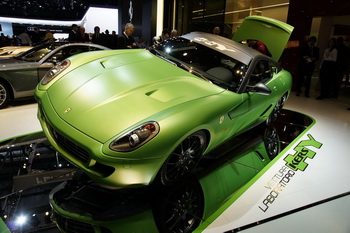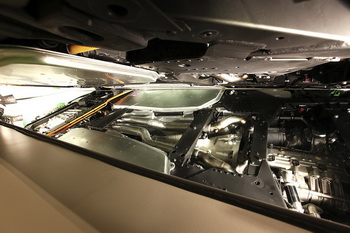
 |
|
The star of the Ferrari stand in Geneva
today is the 599 GTB "HY-KERS" vettura
laboratorio (experimental vehicle), an
example of how Ferrari is approaching the
development of hybrid technology without
losing sight of the performance traits and
driving involvement that have always
exemplified its cars |
|
 |
|
|
|
The star of
the Ferrari stand in Geneva today is the 599 GTB "HY-KERS"
vettura laboratorio (experimental vehicle), an
example of how Ferrari is approaching the development of
hybrid technology without losing sight of the
performance traits and driving involvement that have
always exemplified its cars.
This hybrid
project is also aimed at ensuring that Ferrari will be in a
position to comply with future CO2 emissions standards,
particularly in terms of the urban cycle. City driving is
traditionally where sports cars are most penalised as their
engines are designed for maximum efficiency and performance
at high revs, whereas the urban cycle involves low revs and
low engine loads.
Ferrari has
employed its racing experience to adapt an advanced,
lightweight hybrid drivetrain to the 599 GTB Fiorano with
the aim of ensuring that vehicle dynamics are unaffected.
This was achieved by the careful integration of all system
components, positioning them below the centre of gravity and
ensuring that interior and luggage space are entirely
unaffected. Similarly the flat lithium-ion batteries are
positioned below the floorpan. The result is a centre of
gravity that is even lower than in the standard car.
Ferrari has also
applied its F1 technology to the design, engineering and
construction of a new kind of electric motor which helps
optimise the longitudinal and lateral dynamics of the car,
enhancing traction and brake balance. The motor also
features a unique cooling and lubrication system for maximum
efficiency under all operating temperatures and loads.
Weighing about
40 kg, the compact, tri-phase, high-voltage electric motor
of the HY-KERS is coupled to the rear of the dual-clutch
7-speed F1 transmission. It operates through one of the
transmissionís two clutches and engages one of the two
gearbox primary shafts. Thus power is coupled seamlessly and
instantaneously between the electric motor and the V12. The
electric motor produces more than 100 hp as Ferrariís goal
was to offset every kilogram increase in weight by a gain of
at least one hp.
Under braking
the electric drive unit acts as a generator, using the
kinetic energy from the negative torque generated to
recharge the batteries. This phase is controlled by a
dedicated electronics module which was developed applying
experience gained in F1 and, as well as managing the power
supply and recharging the batteries, the module also powers
the engineís ancillaries (power steering, power-assisted
brakes, air conditioning, on-board systems) via a generator
mounted on the V12 engine when running 100 per cent under
electric drive. It also incorporates the hybrid systemís
cooling pump. This experimental vehicle thus maintains the
high-performance characteristics typical of all Ferraris
while, at the same time, reducing CO2 emissions on the ECE +
EUDC combined cycle by 35 per cent.
|